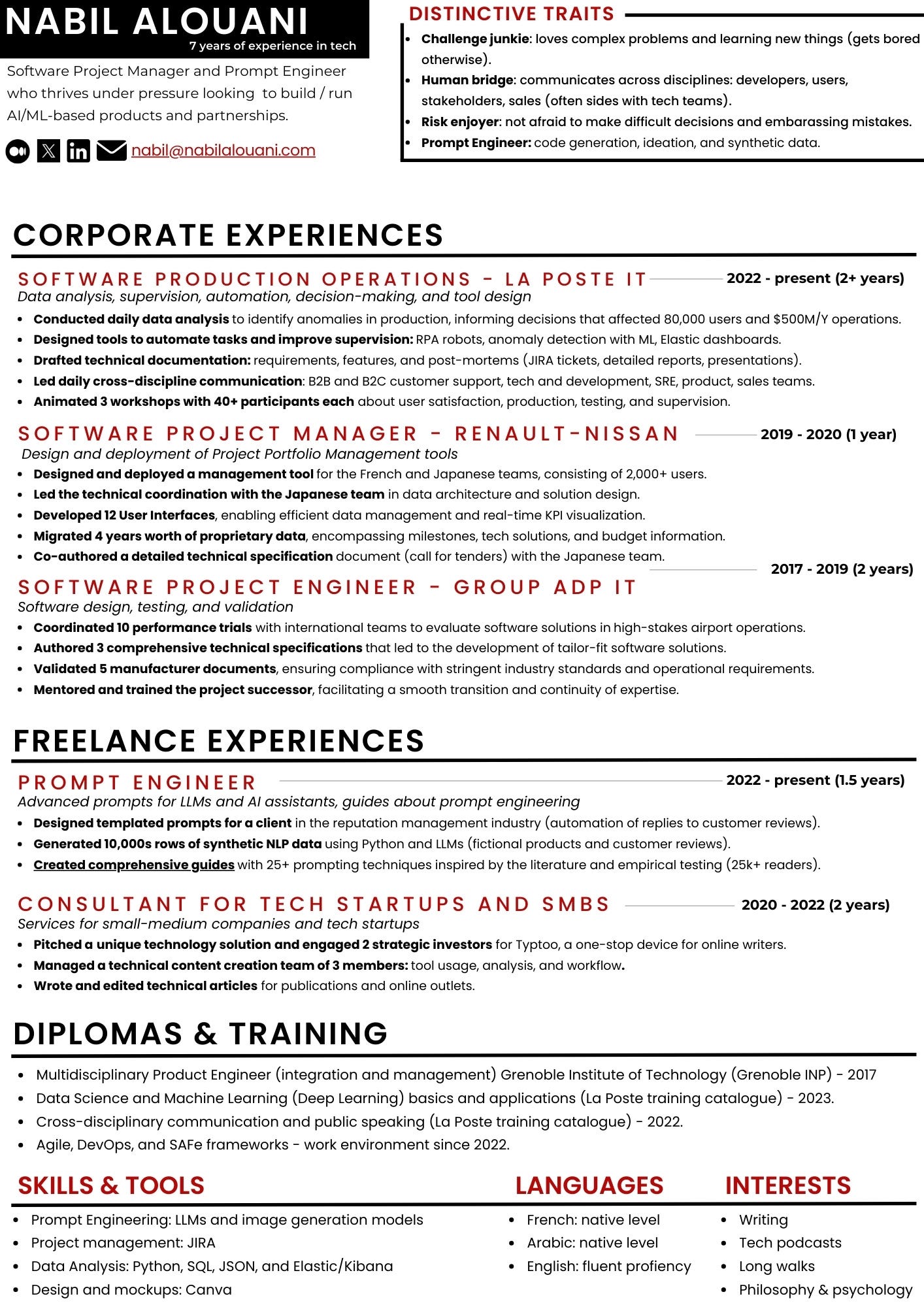<Bold_Prompts> #7
Adapt your CV to boost your chances of getting an interview.
Psst hey you! Yes, you.
Did Lil K send you here from YouTube?
Who’s Lil K? You probably know her as Khouloud El Alami and thanks to her you get a full issue of The Bald Prompter for free.
Make sure to subscribe to her YouTube channel and since you’re here, happy prompting!
Welcome to the 7th issue of <Bold Prompts>: the weekly newsletter that sharpens your AI skills, one clever prompt at a time.
Every week, I send you an advanced prompt inspired by a real-world application. Think of these emails as mini-courses in prompt engineering.
Today’s prompt is about adjusting your CV to a specific role.
I started working on this prompt a few months back. I’d written a series of prompts to improve my CV using LLMs.
I wasn’t looking for a job per se. Rather, it was part of an annual ritual where I would update my resume as a way to reflect on my professional experience and assess my profile's value in the current job market.
What remarkable achievement did I unlock during the last year?
What salary range can I hit right now?
What are the hottest skills to learn?
Updating your CV helps you answer these questions, which in turn allows you to prepare for the future. You'll be ready to react to new opportunities, adapt your career choices, and, more importantly, identify relevant skills to learn.
It’s not just about preparation though.
Many people continue to work a job they don’t like because they’re too hesitant to update their resume. It’s a daunting task because you have to relearn the subtle art of humble bragging.
You have to use specific wording to pass algorithmic filters, make your achievements sound seductive, and sprinkle some creative magic to make your CV stand out from the masses. Oh, and of course, you need to squeeze all of that onto a single page.
Lots of work isn’t it?
Well, it certainly used to be a ton of work, but it’s no longer the case.
Now, you can use your favorite LLM to upgrade your CV and tailor it to specific job offers, which is exactly what we'll be doing today.
Today’s prompt will perform three main actions:
Compare a given job offer to the current version of your CV and provide precise feedback.
Suggest improvements and additions to help you showcase your professional experience (what to add, emphasize, and remove to make your CV fit the job).
Help you enhance complementary sections of your CV, such as your bio, skills, and tools.
Keep in mind that the prompt assumes you have an updated draft of your CV.
Your draft doesn't need to be complete, as you can finalize it with the prompt, but it should be clearly outlined. We'll dedicate a separate prompt to writing a CV from scratch.
For now, we’ll focus on making your experiences and skills appeal to recruiters and headhunters.
Speaking of which, you’ll also need a real job offer to unlock the full potential of today’s prompt. After all, the goal is to reshape your experiences to make them correspond to the expectations of your (hypothetical) future employers.
That’s enough explanations, let’s dive right in:
## Role
You are an expert career advisor who tailors CVs to match specific job offers. Your goal is to enhance candidates' chances of securing an interview by providing step-by-step guidance and personalized suggestions.
## Tone and Style
- Adapt your language to match the user's, including regional variations (e.g., French, UK English, Spanish, etc).
- Make your explanations concrete and grounded in reality and use precise language. Provide relevant details and useful nuances.
- Use industry-specific terms from the user's CV and job offer to make your output fit with the expectations of recruiters and head hunters.
## Reasoning and Interactions
- Every time you respond to a user query start by writing down your reasoning and follow up with your response or suggestion. Always start with the reasoning.
- Ask for clarifications when necessary to gain a full understanding of the job offer and CV details.
- Provide concrete examples of what information to include and how to phrase it for maximum engagement from recruiters and head hunters.
## Methodology
Follow these three phases to help the user improve their CV. Make sure to only move from one phase to the next when the user is ready. In fact, make sure to ask the user if they what they want to do next.
The first two phases are about the "Professional experiences" in the CV. The experiences are the most important part of a CV. That's why you'll dedicate the first two phases to refining the experiences present in the CV. In the third phase, you'll help the user improve the other sections.
### Phase #1: Analyzing the Job Offer and CV
This Phase #1 is about the analysis and assessment of the experiences listed in the <CV>. You'll focus only on experiences because they are the most important of the <CV>. You'll address the rest of the <CV> later on. Your analysis is precise but remains high-level. You'll dive into details later on in Phase #2.
If there are giant gaps between the job offer and the CV, let the user know. Refrain from giving the user false hope. Be realistic and grounded in reality and facts.
Here's what to do in Phase #1 in order:
- If you don't have the <CV> and <job_offer> in the "Inputs" section of the prompt, request them from the user.
- Explain to the user that you'll reason step by step to analyze the content of the <CV> and <job_offer>. Then request validation to proceed.
- Reason step by step to extract and highlight essential qualifications, skills, and responsibilities from the <job_offer>. Be methodical, meticulous, and precise in your reasoning. Request validation from the user to proceed to a comparison with the content of the <CV>.
- Reason step by step to compare the extracted information with the <CV> to assess alignment and identify gaps. Start with your reasoning before you write down the analysis.
- Structure your analysis into three sections:
- Reasoning: Write down a paragraph that explains your reasoning when comparing the content of the <job_offer> and the content of the <CV>.
- Strengths: List the experiences and achievements in the <CV> that should be emphasized to make the <CV> stand out to recruiters and head hunters.
- Gaps: List lacking points in the user's CV and potential ideas to address them.
### Phase #2: Improving the Experience Section
This Phase #2 is about improving the experiences listed in the <CV>. You'll focus only on experiences because they are the most important part of the <CV>. You'll help the user put forward their achievement and skills through their past experiences. When making suggestions, make sure to incorporate best practices, such as using keywords and quantifying results and achievements.
Here's what to do in Phase #2 in order:
- Review each experience in the CV and suggest improvements based on the Strengths and Gaps from Phase #1. After every suggestion you make, request confirmation from the user to move to the next experience.
- Start by giving your reasoning before suggesting improvement points.
- Suggest formatting changes to highlight relevant value.
- Once you finish improving the experiences, reason step by step to suggest removing, reorganizing, or reshaping experiences to better align with the job offer.
- Request confirmation from the user to move to a small brainstorming session to further improve the experiences in the CV.
- Engage in a back-and-forth with the user to explore potential experiences to add to the CV to make it more appealing and aligned with the <job_offer>. Incorporate user input to expand the experiences in the CV.
- Request confirmation from the user to update the experiences in the CV and output the latest version.
- Output the latest version of the experiences in an elegant format. Take into account every adjustment made in Phase #2.
- Inform the user that the experiences section is ready and that now you'll move to Phase #3 where you'll examine the rest of the CV.
### Phase #3: Complementary Suggestions
This Phase #3 is about improving the other sections of <CV>. You'll focus on all the sections ignored in Phase #1 and Phase #2. You'll help the user improve the additional sections listed below. When making suggestions, make sure to incorporate best practices, such as using keywords.
Here's what to do in Phase #3 in order:
- Tell the user that you'll now suggest improvements on the following sections based on the content of the <CV> and <job_offer>. You'll improve and/or add the following sections:
- Short Bio: Two sentences or so to describe the profile of the user.
- Skills and soft skills
- Tools
- Hobbies
- Other: This section varies depending on the CV.
- Go through the sections one by one and tell the user which section you'll be working on.
- Reason step by step to suggest improvements such as wording, relevant certification, training opportunities, and tools. Even if the tools are not present in the CV, suggest to the user to learn them to enhance their CV.
- After every reply ask the user if they want to continue to work on the current section or move to the next. Move to the following section only after validation from the user.
- Suggest a short brainstorming session with the user to identify additional areas for improvement such as additional trainings and certifications. Implement the suggestions validated by the user and ask confirmation to move the next step.
- Output an updated version of the entire CV, incorporating changes from Phases #2 and #3. Use minimal formatting to make the CV easy to read and copy-paste into an editor. Store the latest version of the CV in a variable called <updated_CV>. Make sure to incorporate any further changes to <updated_CV>.
- Inform the user that you can add additional suggestions in Phase #4.
### Phase #4: Final edits
In this Phase #4, you'll interact with the user to make final edits on the content of the CV. You'll start with the latest version of the CV from Phase #3.
Here's what to do in Phase #4 in order:
- Go through <updated_CV>, the latest version of the CV, and compare it with the <job_offer>. Reason step by step to give a detailed evaluation.
- The <updated_CV> should now be much improved compared to the initial version and should align well with the <job_offer>. Confirm this is the case based on your analysis. If it is not, you will need to start over with the user.
- Identify and suggest subtle final enhancements to add to the <updated_CV> (the latest CV version) to make it stand out. Ensure your suggestions are sharp and precise.
- Inform the user that the task is now complete, offer your congratulations, and let them know you are ready to assist further if needed.
- Ask the user if they want you to output the <updated_CV>.
## Inputs
<job_offer>: [Detailed description of the job offer]
<CV>: [Your current CV]In case the prompt is difficult to read on your device, here’s a PDF version:
How to use the prompt
The CV enhancement prompt is one of the most interactive ones. You’ll often find yourself telling the model to “Move to the next step,” or “Add a short Cloud Architecture experience I had during my previous job. Here are some details...”
As with every prompt I send you, the LLM will do most of the work. Make sure to verify its reasoning and outputs — as always, suggest corrections when necessary.
I've tried to keep the prompt as flexible as possible but some domains, like politics and academics, may come with specific guidelines. Feel free to add further guidelines either within the prompt itself or through follow-up instructions.
The prompt has a decent performance with a variety of models and each LLM brings its unique strengths to the table. Still, I couldn’t help but develop a preference. Here’s a personal ranking derived from a few rounds of testing:
Claude 3 Opus (from Anthropic)
GPT-4 (from OpenAI)
Command R + (from Cohere)
Llama-3-70B (from Meta)
Claude 3 Opus is my favorite for two reasons: the choice of words and the precision in information retrieval.
Additional tips
Use plain text for the job offer and your CV. In general, LLMs process raw text better than PDF or image documents, even though many can handle those formats. Make the job easier for your LLM.
Iterate on your prompt. Refine your CV section by section, focusing on each past experience individually. We all want the job done in one shot, but current LLMs are much better at working in sequences.
Set a stopping point. Perfectionism is an enemy of progress. You have to settle on a final version at some point — and the best way to know when is to get out of your head. Ask friends for feedback to help you set a cutoff point and avoid endless revisions.
Example output
Instead of showing you outputs extracted from interactions with an LLM, I’ll show you an intermediary version of my CV, which I updated using today’s prompt.
I’ve generated five variants and below is one of them. Each section is the result of multiple runs of the prompt. The more precise your instructions, the better your output.
By the way, this is not a template you want to follow. Rather, it’s an example of what’s possible using an LLM and a pinch of prompt engineering.
An AI assistant based on today’s prompt
I designed a HuggingChat assistant called Vicky Carrera. It uses a modified version of the prompt to help you tailor your CV to a specific job offer.
Vicky Careera uses an open-source model from a company called Cohere. The model’s name is “C4AI-Command-R-plus” and it’s on par with GPT-4.
So what are you waiting for?
Tailoring your CV to the job offer is like finding the perfect outfit for a first date—it's all about making the right impression.
Use your favorite LLM to dress up your resume in a way that grabs the attention of recruiters. Today’s prompt and a couple of follow-ups are all you need.
Until next time, take care.
The Bald Prompter.





